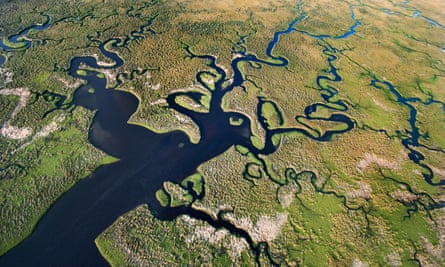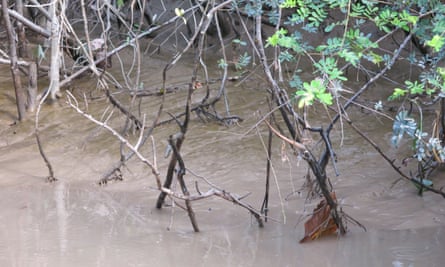Florida’s mangroves have been forced into a hasty retreat by sea level rise and now face being drowned, imperiling coastal communities and the prized Everglades wetlands, researchers have found.
Mangroves in south-east Florida in an area studied by the researchers have been on a “death march” inland as they edge away from the swelling ocean but have now hit a manmade levee and are likely to be submerged by water within 30 years, according to the Florida International University analysis.
“There’s nowhere left for them to go,” said Dr Randall Parkinson, a coastal geologist at FIU. “They are done. The sea will continue to rise and the question now is whether they will be replaced by open water. I think they will.
“The outlook is pretty grim. What’s mind boggling is that we are facing the inundation of south Florida this century.”
Mangroves are made up of coastal vegetation that grows in salty or brackish water. They are considered crucial buffers to storms and salt water intrusion, as well as key habitats for certain marine creatures.
Using aerial photographs, satellite imagery and sediment cores, FIU researchers found that mangroves just south of Miami were migrating westwards over marshland at a rate of about 100ft a year until they were halted by the L-31E levee, a flood barrier in Miami-Dade county, where they are now making their last stand.

Previous research has suggested the same phenomenon has happened in other parts of south Florida, making the region more vulnerable to storms, such as Hurricane Irma, which swept up Florida last year, and land loss as the sea rises further.
Of particular concern is the future of the Everglades, the vast marsh, mangrove and pine flatwoods wilderness that provides a home to threatened species such as the manatee, American crocodile and Florida panther.
The Everglades, known as the “river of grass”, was long nourished by fresh water flowing slowly from marshes, lakes and rivers to the north.
However, the ecosystem has shrunk by around half since a network of canals and dams were built over the past century to divert water for agriculture and to build homes. Swaths of the Everglades have been drained to accommodate a booming human population – more than 6 million people now live in south Florida.
A restoration plan to divert water back to the Everglades has been backed by Congress but the area now faces the existential problem of sea level rise, which is connected to climate change. The oceans are rising rapidly at the largely flat south Florida coastline, around three times faster than the global average. Salt water is entering the Everglades from the coast and from underground aquifers.

“You can restore the plumbing of the Everglades but the question is whether that will be enough,” Parkinson said. “If you have a healthy patient, it will have a higher probability of survival if they are exposed to a virus. The Everglades isn’t a healthy patient, it faces a lot of threats.
“We are at a tipping point. Sea level rise could be more than 20mm [o.79in] a year by the end of the century and there’s no way our coastal habitats will keep pace with anything more than 10mm a year.”
Dr Stephen Davis, a wetland ecologist at the Everglades Foundation who was not involved in the FIU study, said the work illustrates the problems that researchers have witnessed in south Florida in recent years.
“There will still be some mangroves in south Florida but areas will collapse into open water bodies,” he said. “Unabated sea level rise will continue to eat away at the marshes. We should do everything we can to help restore the Everglades to reduce its vulnerability.”

Comments (…)
Sign in or create your Guardian account to join the discussion